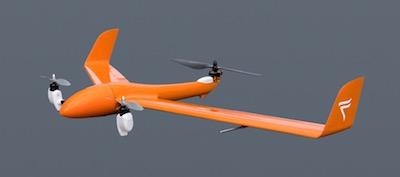Sun, Sep 16, 2018
FlightWave Edge Deployed In Cutting Edge Study Aboard the Schmidt Ocean Institute’s R/V Falkor
The FlightWave Edge UAS was part of a high-tech flotilla of underwater vehicles (AUVs), autonomous surface vessels (ASVs), and unmanned aerial vehicles (UAVs) used on the research ship R/V Falkor in its study of an area of the Pacific Ocean approximately 1,000 miles west of Southern California in an area called the Subtropical Front.

The mission: Establish a new method for observing dynamic ocean systems and processes with autonomous vehicles that maintain constant communication between themselves and a remote control center on the Falkor.
The ecological mysteries of the Subtropical Front are extremely important for scientists to unravel and understand, and also offer a highly valuable opportunity for researchers to experiment with the simultaneous management of multiple autonomous vehicles.
Principal Investigator João Tasso de Figueiredo Borges de Sousa of the Laboratório de Sistemas e Tecnologias Subaquáticas (LSTS) from Porto University and his team are leading the effort, along with researchers from the Interdisciplinary Centre of Marine and Environmental Research (CIIMAR), a leading research and advanced training institution of the University of Porto in Portugal; Technical University of Cartagena in Spain; Norwegian University of Science and Technology in Norway; and U.S. researchers from Harvard, University of Rhode Island, and Lamond-Doherty Observatory.
The Edge worked as part of a system of autonomous marine vehicles to map out ocean fronts. Researchers will use it to try out three types of sensors: a thermal camera to measure sea surface temperature, a multispectral camera to detect plankton, and a special sensor made by NASA that measures a gas called DMS emitted by plankton.
“Operating from a ship out in the middle of nowhere enables us to demonstrate the Edge’s versatility and airworthiness,” said FlightWave co-founder and CTO Trent Lukaczyk, Ph.D. — who is part of the team at sea. “And there’s only one good place to land: back on the ship. The Edge’s VTOL and payload swapping are important capabilities out here. And networking into a system of autonomous assets via the Falkor’s network and supercomputer puts this demo on a whole new level.”
(Source: FlightWave news release. Image from FlightWave website)
More News
Its Offerings Are Lighter, Cleaner, and Now Pushing Past 1,000nm on SAF Jet Fuel DeltaHawk’s diesel-powered aircraft lineup has seen incredible upgrades over the last few yea>[...]
The Airplane Experienced A Total Loss Of Engine Power On December 3, 2025, about 1600 central standard time, a Mooney Aircraft Corp. M20K, N57229, was substantially damaged when it>[...]
Make Sure You NEVER Miss A New Story From Aero-News Network Do you ever feel like you never see posts from a certain person or page on Facebook or Instagram? Here’s how you c>[...]
Aero Linx: European Society of Aerospace Medicine (ESAM) As a pan-European, independent forum, it works to promote the safety and health of all persons involved in aviation and spa>[...]
“We are excited to see Wisk achieve this milestone, and I’m so proud of the team that made it possible. The team at Wisk has built advanced technologies across flight c>[...]
 Aero-TV: DeltaHawks Diesel Power Steps Into the Spotlight
Aero-TV: DeltaHawks Diesel Power Steps Into the Spotlight NTSB Prelim: Mooney Aircraft Corp. M20K
NTSB Prelim: Mooney Aircraft Corp. M20K ANN FAQ: Turn On Post Notifications
ANN FAQ: Turn On Post Notifications ANN's Daily Aero-Linx (12.20.25)
ANN's Daily Aero-Linx (12.20.25) Aero-News: Quote of the Day (12.20.25)
Aero-News: Quote of the Day (12.20.25)



